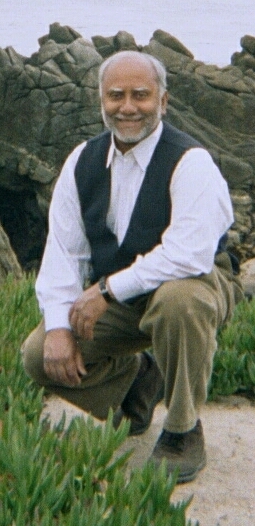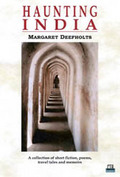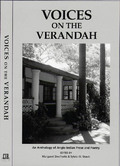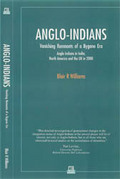Sharing Travels and Memories
An Appreciation of Deefholts'
Haunting India
If you want to have a wonderful armchair glimpse into some nifty and unusual spots in India, do “travel” to the website of Canadian travel writer, author, online e-zine publisher, and raconteur, Margaret Deefholts — where you will find links to portions of her book Haunting India (www.margaretdeefholts.com).
Published in 2003 as a fund-raiser for Calcutta Tiljallah Relief (CTR), an organization devoted to bettering the living conditions of aged and sometimes homeless Anglo-Indians in various parts of India, Margaret’s book is a compendium of writings, musings, memoirs, short stories, and personal anecdotes written from the viewpoint of someone who left India in the 1970’s to emigrate to Canada, but most clearly left behind her heart.
One can sense the deep and abiding love of the land she forsook to travel with her husband from Calcutta to Vancouver, in part, as all immigrants do, to seek a better life for her two children.
Margaret, whose maiden name was Margaret Penn-Anthony, was the child of Anglo-Indian parents who lived in many parts of India and traveled extensively on the railways.
Her father was an accountant and financial officer on the Indian Railways Administrative Service. Many of her family anecdotes describe the wonderful train journeys she recalls from her childhood, berthed in luxurious private compartments, called saloons, with private butlers and cooks to attend to all the family’s needs.
Imagine journeying through India’s small towns and villages in a huge steam-engine train, wheels clacking and whistles blowing through the night, inhaling the sooty and smoky aromas from a hundred village chulas as farmers and families prepared their sparse evening meals.
Imagine yourself to be a child surrendering your senses to the fields of green, the rice paddies, the small rivers, the trees, and the distant sunsets, seated near a window, with piles of books to read and not a care in the world.
With her father’s various postings to different railway towns and cities, Margaret and her little sister occasionally had to be sent to convent schools as boarders.
Most of her early, middle, and high school educational experiences were centered in convents run by Catholic nuns where attention was paid to learning the classics in Literature; mastering the works of English poets such as Keats, Coleridge, Wordsworth, and Shelley; and reciting poems with perfect “enunciation.”
It was at one such school, St. Joseph’s Convent of Nagpur, that Margaret and I became classmates and friends while completing our studies towards the Senior Cambridge Certificate. She was a lively and charming character with an impish sense of humor and not above various forms of mischief, which got us into scrapes with our dour and humorless nuns and teachers.
Our days were filled with games of hockey, seven tiles, kick-the-can, cricket, and many other fun activities.
After high school Margaret moved away from Nagpur and over the years I lost touch with her.
It was in the winter of 2004 when I was surfing the net late one night looking at various Anglo-Indian websites that her name jumped out at me.
Penn-Anthony is not the commonest of names and to see the name Margaret Penn-Anthony gave me a moment of excitement.
I at once sent an email: “Are you the Margaret Penn-Anthony who attended St. Joseph’s Convent in Nagpur?” I asked.
The reply came almost instantly. I was so thrilled. Margaret and I began to exchange emails, recapping our lives over the past 40 or more years. One of the greatest pleasures the Internet has brought to humanity is the ability to find long-lost friends.
And one of my greatest pleasures was discovering what a prolific and profound writer my old school pal had become!
I would highly recommend
reading Haunting India.In Haunting India Margaret invites us to share her travels to Rajasthan where she attended the world-famous Pushkar camel fair and festival, to the backwaters of Kerala where one can take a boat ride and glide through lush, tropical greenery, visit game sanctuaries such as Periyar and view pepper and cardamom plantations.
She whisks us off to grand old Bombay (now called Mumbai) to experience the unique charms of this bustling city, to Calcutta, home to many historic British Raj monuments and buildings, and to several other cities and provinces of India.
For someone contemplating a trip to India, I would highly recommend reading Haunting India. You can get all the factual information you need on a particular country from the ever familiar Frommer’s guides or other travel books, but you can only get descriptions of the bakeries of yesteryear and the kati-kabab joints of Calcutta from Margaret’s enticing — and haunting — book.Click here for publication info on this book
from Blair Williams' website.
Or copy and paste into your browser:
http://www.blairrw.org/ctr/haunting.htm
Read More About Quentine Acharya In
Career Visions Of People Remaking
Our Small Planet: Issue #7
http://indiawritingstation.squarespace.com/struggle-to-learn-english/
More Books on Anglo-India
Book Review
The Way We Were
Will Move Diasporic
Communities EverywhereThe Way We Were: Anglo-Indian Chronicles.
Edited by Margaret Deefholts and Glenn Deefholts.
Published by Blair R. Williams, CTR Inc Publishing,
PO Box 6345, Monroe Township, New Jersey, U. S.
$16.95
Reading this anthology of 42 essays was an unexpectedly moving experience for me.
The lives and times of the Anglo-Indian community under the British Raj, their colors, sounds, smells, and tastes, came alive through the memories of Anglo-Indian and non-Anglo-Indian writers living in Australia, Canada, India, New Zealand, U. K., and U. S.
But, first, who are the Anglo-Indians?
Publisher Blair R. Williams aptly describes them as “a hybrid people of Indian and European descent.”
Until India’s independence in 1947, the Anglo-Indians were a mainstay of the Raj’s communication and control infrastructure—the Indian Railways, Post and Telegraphs, Police, and Customs.
In the years immediately after 1947, there was a voluntary
mass out-migration of a majority of the Anglo-Indian community
Instead of getting bogged down in interpretations of this exodus immediately after the British Raj as a sad commentary on the fears prevalent in those times, the 42 writers who contributed to this anthology mainly revisit their fond personal memories of an India that no longer exists.
In doing so, they spark emotions around universal themes of loss and displacement.
Consequently, besides Anglo-Indians and their progeny, this book will be attractive to a wider readership, and be of special significance to: diasporic communities everywhere; people who study them; Indophiles; Anglophiles; and people interested in the do’s and don’ts of nation building.
According to Publisher Williams, as in the case of Voices in the Verandah, the gross proceeds of all sales will got to helping indigent Anglo-Indians in India through CTR’s charitable activities. The publishing costs are privately borne.
Kudos to the writers, editors, publisher, and CTR for their successful collaboration in bringing to a wider audience the past of a community whose contributions to India’s infrastructure development, and much more, have yet to be fully recognized.
—Michael Chacko Daniels
Editor & Publisher, New River Free Press InternationalThe 42 Writers
Featured in The Way We Were
Quentine Acharya, Rochelle Almeida, Robyn Andrews, Jaysinh Birjepatil, J. Chloe Braun, Cynthia Brush, Stanley Brush, Geraldine Charles, Dolores Chew, Daphne Ruth Clarke, Glenn Deefholts, Margaret Deefholts, Susan Deefholts, Lilian Gifford, Nancy Rixon Lilly, Lionel Lumb, Esther Lyons, Patricia McGready Buffardi, Noel Maitland McKertich, David McMahon, Phyllis Merchant Beavan, Joyce Mitchell, Pam Moore, Ralph N. Moore, Peter Nailer, Kevin Peterson, Victor Rangel-Ribeiro, Pamela (“Joy”) Rebeiro, Rani Sircar, Sylvia W. Staub, Lisa Vassou, John Walke, Denis Whitworth, Blair Williams, Ellen Williams, Noreen Wood, Dean Wright.The Backstory on
The Way We Were
“In 2004 The Way We Were was launched, inviting articles from across the world that described Anglo-Indian culture. As we stated in the guidelines:
‘The publication, depicting our Anglo-Indian way of life, will cover a broad contemporary canvas. We would like to capture not only who we were but how we were in all walks of life - the way we lived, worked, rejoiced, loved, laughed, and cried.’
“Over 80 submissions from both Anglo-Indians and non Anglo-Indians were received from India, Australia, USA, UK, Canada, New Zealand, and Germany. A panel of five judges selected 42 articles through a blind judging process, and these now constitute the content of The Way We Were. The anthology has been edited by Margaret and Glenn Deefholts. . . .
“It joins Anglo-Indians: Vanishing Remnants of a Bygone Era, Haunting India, and Voices On The Verandah, a series of books about Anglo-Indians.
“The publication of this book has another vitally important and synergistic function. The gross proceeds of all sales—publishing costs are borne privately—will go directly to CTR Inc., the charity helping less fortunate Anglo-Indians in India. The series thus serves a dual purpose: to preserve the culture of the Community and to provide much needed resources for its poorer members in India.”
—Blair Williams, Publisher, CTR Inc Publishing
“Blair Williams, the publisher of this effort, is a Chartered Engineer (London) who immigrated to the USA from India in 1976. He has spent the last 24 years as an executive in manufacturing companies and is now an Industry Professor at Brooklyn Polytechnic. He is the author of a technical publication, Manufacturing for Survival (Pearson 1997).
“On a visit to India in 1998 he was appalled to see the condition of the seniors of his Community, evoking the all too distressing realization that, ‘There, but for the grace of God, go I.’ On his return he set up CTR Inc., a 501c(3), 'Not For Profit' charity, expressly to help indigent Anglo-Indians in India. Today the charity provides monthly pensions to over 230 seniors in three major cities in India and is helping to educate over 100 children.”
Reprinted with permission from:
http://www.blairrw.org/ctr/waywewere_pub.htmOr copy and paste into your browser:
http://www.blairrw.org/ctr/waywewere_pub.htm

Or copy and paste into your browser:
http://www.blairrw.org/ctr/voices.htm
Or copy and paste into your browser:
http://www.blairrw.org/ctr/anglos.htm
DISCLAIMER ABOUT WEBSITE LINKS : US-India Writing Station has links to other websites. It also identifies other publicly accessible websites with which it does not have two-way links. When you link to another site from US-IWS, you are no longer on the US-IWS website, even if the article written on the other website was authored by someone affiliated with it, or mentioned on it. US-India Writing Station's Privacy Policy will not apply on these other websites. Be aware that when you link to another website, you are subject to the privacy policy of that new site.






